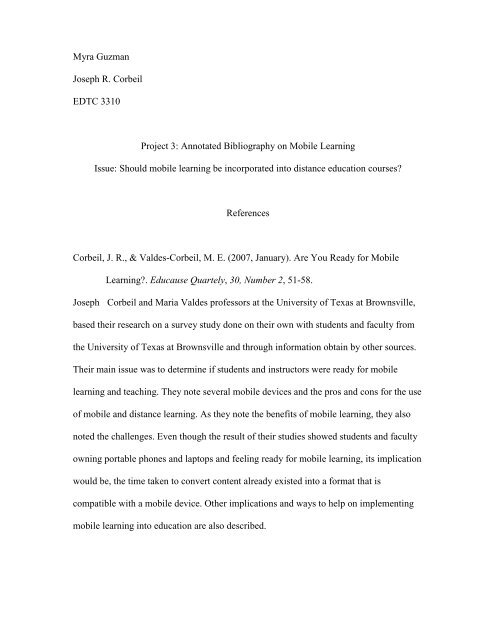Myra Guzman Joseph R. Corbeil EDTC 3310 Project 3: Annotated ...
Myra Guzman Joseph R. Corbeil EDTC 3310 Project 3: Annotated ...
Myra Guzman Joseph R. Corbeil EDTC 3310 Project 3: Annotated ...
You also want an ePaper? Increase the reach of your titles
YUMPU automatically turns print PDFs into web optimized ePapers that Google loves.
<strong>Myra</strong> <strong>Guzman</strong><br />
<strong>Joseph</strong> R. <strong>Corbeil</strong><br />
<strong>EDTC</strong> <strong>3310</strong><br />
<strong>Project</strong> 3: <strong>Annotated</strong> Bibliography on Mobile Learning<br />
Issue: Should mobile learning be incorporated into distance education courses?<br />
References<br />
<strong>Corbeil</strong>, J. R., & Valdes-<strong>Corbeil</strong>, M. E. (2007, January). Are You Ready for Mobile<br />
Learning?. Educause Quartely, 30, Number 2, 51-58.<br />
<strong>Joseph</strong> <strong>Corbeil</strong> and Maria Valdes professors at the University of Texas at Brownsville,<br />
based their research on a survey study done on their own with students and faculty from<br />
the University of Texas at Brownsville and through information obtain by other sources.<br />
Their main issue was to determine if students and instructors were ready for mobile<br />
learning and teaching. They note several mobile devices and the pros and cons for the use<br />
of mobile and distance learning. As they note the benefits of mobile learning, they also<br />
noted the challenges. Even though the result of their studies showed students and faculty<br />
owning portable phones and laptops and feeling ready for mobile learning, its implication<br />
would be, the time taken to convert content already existed into a format that is<br />
compatible with a mobile device. Other implications and ways to help on implementing<br />
mobile learning into education are also described.
Jones, R. (2009). Physical ergonomic and mental workload factors of mobile learning<br />
affecting performance of adult distance learner’s student perspective. Orlando,<br />
Fla.: University of Central Florida.<br />
Rochelle Jones, from the University of Central Florida and author of the book, based its<br />
research on surveys and studies obtained by various sources. The author focuses the<br />
attention on distance education and adult learners, stating the advantages of mobile<br />
learning. The author states that mobile learning cost less than a regular computer and is<br />
more accessible for distance education students. Therefore, the use of mobile learning in<br />
distance education is more in demand in several countries.<br />
Koole, M., McQuilkin, J. L., & Ally, M. (2010). Mobile Learning in Distance Education:<br />
Utility or Futility?. The Journal of Distance Education, 24(2), 59-82.<br />
The authors of this informative journal are faculty members at the Distance Education,<br />
Athabasca University. They based their research results on a study done at a Canadian<br />
distance education University with 16 graduate education students, with the use of a<br />
program called MobiGlam that allowed access to Moodle course materials. The focus of<br />
this study was to know the impact mobile learning played on distance education students.<br />
Throughout the study implications for installing and locating the program in the student’s<br />
mobile devices occurred requiring for immediate technical support assistance. The<br />
researchers concluded that it would be difficult to design course material for mobile<br />
learning because of the rapid changing of mobile devices.
Koszalka, T., & Ntloedibe-Kuswani, G. S. (2010). Literature on the safe and disruptive<br />
learning potential of mobile technologies. Distance Education, 31(2), 139-157.<br />
The authors of this informative educational journal have investigated through research<br />
studies the issue of safe and disruptive learning of mobile technologies. The authors<br />
investigated several research cases and found that even though mobile learning benefits<br />
safely distance learning in poor and other communities that had easy access to cell<br />
phones, there were disruptions problems that occurred during the implementation of<br />
information into the mobile device such as, storage space, access, and bandwidth issues.<br />
Great consideration of the implementation of instruction into the mobile device needs to<br />
be taken for it to be a great success.<br />
Kukulska-Hulme, A. (2007). Mobile Usability in Educational Contexts: What have we<br />
learnt?. The International Review of Research in Open and Distance Learning,<br />
8(2), 1-16.<br />
Agnes Kukulska-Hulme a Senior lecturer in Educational technology from The Open<br />
University in UK, based its research from studies and issues from projects done at the<br />
same University in UK on mobile learning. The author emphasizes the need for<br />
improving mobile learning by the issues address for distance education students. Mobile<br />
learning has educational limitations factors on its usability which complicate its<br />
incorporation into distance education. This journal provides information, that points to<br />
the new generation of mobile and distance learners.
Kurubacak, G. (2007). Identifying Research Priorities and Needs in Mobile Learning<br />
Technologies for Distance Education: A Delphi Study. International Journal of<br />
Teaching and Learning in Higher Education, 19(3), 216-227.<br />
Gulsun Kurubacak, an associate professor in Applied Communication at the College of<br />
Open Education of Anadolu University, based her research study on issues from<br />
participants on mobile learning. She also based on four questions that focus to identify,<br />
categorize, rank the priorities, and needs for mobile learning in education. However, she<br />
states there are problems, dilemmas and arguments that need to be address and overcome<br />
for the future use of mobile learning in distance education, some are multicultural<br />
diversity, workers diagnosing communication problems, technical support, and social<br />
adjustments. Online workers can benefit by understanding the future needs and priorities<br />
before implementing the use of mobile learning in distance education.<br />
Mance, I. (n.d.). Discussion of Mobile Learning Research and Trends in Academia.<br />
Unique Instincts. Retrieved November 14, 2011, from<br />
http://uniqueinstincts.com/index.php?option=com_content&view=article&id=29:<br />
discussion-of-mobile-learning-research-and-trends-in-academia&catid=22:imani<br />
-mance-papers&Itemid=70<br />
Imani Mance, a graduate student and research assistant in instructional technology at<br />
Georgia State University. She informs about the benefits, disadvantages and trends of<br />
mobile learning through research and studies from other sources to further explore the<br />
area of mobile learning into distance education. The studies that are mention seem to<br />
have benefit more on the use of mobile learning for distance education.
Park, Y. (2011). A Pedagogical Framework for Mobile Learning: Categorizing<br />
Educational Applications of Mobile Technologies into Four Types. International<br />
Review of Research in Open and Distance Learning, 12(2), 78-102.<br />
Yeonjeong Park, from Virginia Tech USA, the author of this informative journal, based<br />
her study on previous research from other sources and previous studies. The author<br />
classifies studies that were previously done on this topic into four types to help the reader<br />
understand the characteristics of mobile learning in distance education. Even though<br />
some limitations are address in this journal, the research studies that are noted focus their<br />
attention more on the benefits of mobile learning which are more. This journal provides<br />
useful information that will be of help for instructional designers to incorporate mobile<br />
technology into teaching.<br />
Rooyen, A. v. (2008). Integrating Mobile Technology into a Distance Education<br />
Accounting Module. Proceedings of the 3rd international conference on<br />
e-learning (pp. 475-479). Reading: Academic Pub..<br />
Annelien Van Rooyen, conference committee participant e-learning community, PhD<br />
candidate at the University of South Africa, wrote a paper on Integrating Mobile<br />
Technology into a Distance Education Accounting Module, based on her research of<br />
mobile technology in distance education and its impact. She states that the purpose of the<br />
research was to find an affordable and accessible technology device to help learners<br />
throughout their studies that would help to obtain faster information and communication<br />
from their professors and help reduce the drop rate. It concluded as the cell phone being<br />
the device most own and used by students.
Traxler, J., & Kukulska-Hulme, A. (n.d.). Commonwealth of Learning - Mobile<br />
Learning in Developing Countries. Commonwealth of Learning - Home.<br />
Retrieved November 14, 2011, from<br />
http://www.col.org/resources/publications/trainingresources/knowledge/Pages/m<br />
obileLearning.aspx<br />
The authors of this informative article, based their research on case studies and<br />
information obtained from other sources. The authors inform about the advantages and<br />
challenges that exist in the use of mobile learning for distance education in developing<br />
countries. The challenges for learners are many, but the advantages are more. The<br />
delivery of education in developing countries is able to be obtained by means of mobile<br />
learning. The incorporation of mobile learning into distance education can be of great<br />
advantage for the disadvantage students.<br />
APA formatting by BibMe.org.



